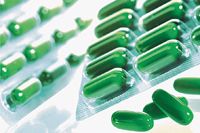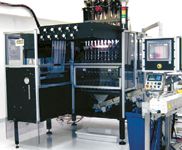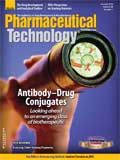Innovations for 2012
Packaging innovations boost productivity, meet regulatory requirements, and protect products.
A new year is a good time to look forward as well as backward. New developments in 2012 will support the 10 major trends of 2011, which include increased automation, particularly for quality-control functions; implementation of serialization and traceability technology; adoption of anticounterfeiting measures; new choices in blister material; braille on labels; improvements in cold-chain practices; greater use of prefilled syringes and single-use product-contact parts; rising interest in stick packs; and stronger emphasis on sustainable processes, packaging, and logistics (see "Sustainability Outside the Box" in the October 2011 issue of Pharmaceutical Technology).

Hallie Forcinio
Automation
Servo technology and software are bringing a new level of automation to pharmaceutical packaging. Software not only automates functions, but also simplifies the work of packaging line operators as well as the collection and analysis of productivity data. One new software product oversees multiple quality-control systems on a single packaging line or multiple lines in one or more facilities. A dashboard system and color-coded machine icons on the operator interface quickly alert operators and management to quality problems in real time so remedial action can be taken and downtime can be minimized or eliminated. Remote setup prevents unauthorized changes to settings and errors and supports consistent operation across lines and facilities. The program currently oversees checkweighers, metal detectors, and X-ray inspectors and will accommodate machine-vision systems in 2012 (ProdX software, Mettler-Toledo).
Software's potential to simplify operation is particularly evident in machine vision, a technology with a reputation for being difficult to set up, operate, and change over. In one system, Windows-based software oversees as many as four color or monochrome cameras and performs tasks, including inspecting labels, caps, containers, and fill levels, confirming the presence and condition of a tamper ring, and verifying date and lot codes and one- and two-dimensional barcodes. Capable of checking 2000 metal, glass, or plastic containers each minute, the system includes an integrated reject system (TotalVu Sensor vision system with Teledyne Dalsa cameras, Teledyne TapTone).
Serialization and traceability
With pedigree regulations looming or already in place in some countries, interest is high in implementing serialization systems that generate the supporting data. One serialization-ready printer–applicator prints a two-dimensional DataMatrix code and human-readable data on a label before applying it. A built-in camera verifies print quality (BL400VTEXL label printer and application, Marchesini Group). Data transmission, aggregation, and storage is provided by integrated hardware and software (Systech Serialized Product Tracking, Systech International).
Anticounterfeiting measures
Although the pharmaceutical industry has had some success in countering counterfeiters with multilevel overt and covert security features, fake or diverted products continue to endanger consumers worldwide. Because counterfeiters can't duplicate what they can't see or readily detect, covert features, such as tiny taggants, rank as an essential anticounterfeiting tool.

We’ll be seeing more ...
One taggant-based technology enables smooth adoption by blending the taggants in ink, varnish, thermal-transfer ribbon, resin, or film. In its latest iteration, taggants are combined with inkjet ink that's invisible under visible or ultraviolet light. Detection of the alphanumeric characters or barcode printed with the taggant-equipped ink is only possible with a programmable handheld reader, which provides authentication in seconds. Tight oversight of the supply chain ensures secure handling of taggant carrier materials (Traceless AD inkjet ink and reader, Eastman Kodak).
Blister innovations
A thick polychlorotrifluoroethylene (PCTFE) film provides ultrahigh barrier properties for blister packaging and runs on existing thermoforming equipment with only minor adjustments. At 152.4 µm, the film measures 50% thicker and improves water-vapor-transmission barrier properties 50% compared with previous offerings. The enhanced barrier properties allow moisture-sensitive medicines to withstand the hottest and most humid environments, including Climatic Zones IVA and IVB as defined by the World Health Organization. With this material, pharmaceutical companies can standardize packaging worldwide. The clear film provides product visibility and reduces package size as much as 55% versus cold-formed foil, the traditional barrier material for ultrasensitive products (Aclar UltRx 6000 film, Honeywell Specialty Materials).

Foil-free Alu-Look blister films run on standard thermoforming equipment.
At least two blister-material converters produce laminations with one layer of the ultrahigh-barrier PCTFE. One is a two-layer PCTFE–polyvinyl chloride (PVC) lamination (Pentapharm Aclar PA600/02 barrier film, Klöckner Pentaplast Group).

The Pentapharm Aclar PA600/02 barrier lamination seals to any vinyl-compatible lidstock.
For a stronger moisture barrier, the PCTFE can be laminated to polypropylene, cyclic olefin copolymer (COC), polyethylene terephthalate glycol, polyethylene, or ethylene vinyl alcohol. In fact, one structure, consisting of PCTFE laminated to a ply of coextruded COC is claimed to boost barrier properties as much as 80% compared with current high-barrier PCTFE–PVC laminations (Aclar UltRx 6000 laminations, Tekni-Plex). A foil-free PVC with barrier properties and a foil-like, light-blocking appearance is another alternative to cold-formed foil and aluminum strip packaging (Alu-Look blister films, Tekni-Plex).

Meda uses Sleever International’s braille labels for its Betadine disinfectant sold in Italy.
Braille on labels
When European 2004/27/CE directive took effect on Jan. 1, 2006, it made braille labeling mandatory on all new pharmaceutical packaging. Since then, a growing number of options have been introduced to help pharmaceutical packagers comply.
To overcome a lack of harmonization in the configuration of braille messages, one producer of shrink-sleeve labels has standardized character string alignment on the left and reading from left to right. It also specified the distance between dots, their width, their height, the distance between each group of six dots (which corresponds to a letter) and interlines. A proprietary marking method and morphing tool ensure characters are formed in compliance with parameters and do not become distorted during the heat-shrinking process (Sleever Braille, Sleever International).
Better cold-chain practices
The expanding number of temperature-sensitive biologic products and increased regulatory insistence on proper handling across the supply chain is keeping the spotlight on packaging components that protect products from temperature excursions. A flat, USB-equipped waterproof label about the size of a sugar packet monitors temperature conditions at the pallet, carton, or item level. Surface readings provide a more accurate time or temperature record than the ambient readings taken by conventional time and temperature loggers. When the product reaches its destination, light-emitting diodes on the label flash if temperatures exceeded parameters. Plugging the label's USB connection into a computer uploads the trip's time and temperature history (XpressPDF Label, PakSense).

The XpressPDF Label uploads time and temperature data directly to a personal computer through its USB port.
Prefilled syringes
Prefilled syringes are gaining market share over traditional vials because they offer great dose accuracy, simplify administration, and eliminate overfill, among other reasons (1). As a result, this packaging format, particularly autoinjector versions, often is selected for products destined for self-injection. One off-the-shelf, disposable autoinjector shown at INTERPHEX 2011 hides the needle before, during, and after the injection and is designed to be handled by people with limited dexterity. The initial offering, a 1-mL long syringe with a 0.5-in. staked needle, is available in push-to-activate and press-button–push-to-activate configurations. Both designs provide visual and audible feedback of activation and automatically retract the needle (OTS Autoinjector, bespak injectables, filled by Catalent).

Pharma Tech Industries has installed a Stik Pak S/N 307 formâcrimpâfillâseal machine from Ropak.
Single-use product-contact parts
Attendees at INTERPHEX 2011 also had a chance to explore the possibility of converting to single-use product-contact parts. A single-use fluid path ensures purity, simplifies validation, and expedites changeover on high-throughput peristaltic filling and capping systems (AsepticSU single-use fluid path technology, Flexicon Liquid Filling).
Pharmaceutical packagers switching to disposable product paths have a growing number of pump choices, including 6- and 50-cm3 peristaltic pumps as well as a rolling diaphragm pump (PreVAS Single-use Dosing System, Robert Bosch Packaging Technology).
Stick packs
The appeal of skinny stick packs includes ease of opening, ease of dispensing, and portability, plus the convenience and accuracy of single-dose dispensing. In response to rising interest in this flexible packaging format, Pharma Tech Industries, a contract manufacturer and packager of powder products, installed a machine that forms, crimps, fills, and seals the slender, cylindrical packs (Stik Pak S/N 307 machine, Ropak Manufacturing).
Set up to handle 10 lanes simultaneously, the machine produces 600 stick packs/min and features in-line collation and cartoning, as well as a color touch-screen operator interface. Servo-driven continuous motion corrects deviations. An adjustable dosing system allows tool-less changeover of dosing-specific components.
Hallie Forcinio is Pharmaceutical Technology's Packaging Forum editor, 4708 Morningside Drive, Cleveland, OH 44109, tel. 216.351.5824, fax 216.351.5684, editorhal@cs.com.
Reference
1 K. Abdelkader, R.M. Akers, and M.J. Akers, "Sterile Prefilled Syringes: Market Dynamics & Current Issues in Manufacturing & Control," in Prefilled Syringes, Innovations that Meet Growing Demand (ONdrugDelivery, Newtimber, UK, 2005), p. 4.

Pharmaceutical Tariffs Are Imminent: How Industry is Bracing for Impact
April 16th 2025On April 14, 2025, the Trump Administration launched a national security-driven investigation into pharmaceuticals, a move that will likely result in tariffs being placed on pharmaceutical drugs, ingredients, and other components that are imported from outside of the United States.
Drug Solutions Podcast: A Closer Look at mRNA in Oncology and Vaccines
April 30th 2024In this episode fo the Drug Solutions Podcast, etherna’s vice-president of Technology and Innovation, Stefaan De Koker, discusses the merits and challenges of using mRNA as the foundation for therapeutics in oncology as well as for vaccines.